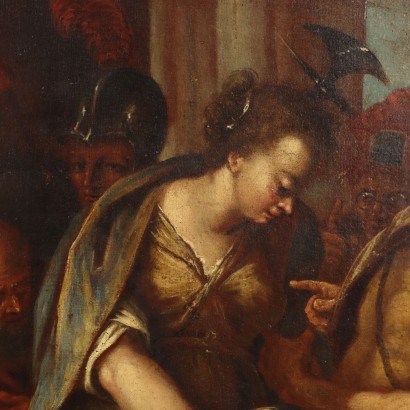Oil on Canvas Religious Subject Italy XVIII Century
Features
Artwork title: Cristo e l'adultera
Artistic school: Venetian School
Age: 18th Century / 1701 - 1800 , 17th Century / 1601 - 1700
Subject: Sacred Subject
Origin: Italy
Artistic technique: Painting
Technical specification: Oil on Canvas
Description : Cristo e l'adultera
Oil on canvas. Venetian school of the seventeenth-eighteenth century. On the back there is a label from the Di Rosa Art Gallery, which attributes the work to the "Venetian School of 1600". The great scene, rich in figures and very animated in the intertwining and superimposition of the bodies, tells the episode of the Gospel of John in which a woman caught in adultery is brought before Jesus by scribes and Pharisees to find out his opinion about the his sentence to be stoned. Jesus, while writing on the ground with his finger, urges his interlocutors to be merciful with the phrase "Let him who is without sin cast the first stone", thus saving the woman from the death sentence and leaving her free to go, with the exhortation not to sin anymore. The subject has been extensively re-proposed in art, with different views on the characters. In this painting, the woman is in a central position, but all the other characters around her make the gaze converge downwards, towards the hand with which Jesus, crouched, is writing on the ground; both the face and the right arm of the woman are practically parallel to those of Christ, as if they followed and conformed to the direction that Jesus indicates to her. In the other numerous figures curiosity dominates, the intent to understand, the question that Jesus raises with his question, represented in multiple expressive variants of both faces and bodies; curious is the detail of the lenses - the glasses of the priest whose head comes out behind the woman and the magnifying glass of the crouched figure on the left in the background - which two figures use to "see better" what is happening. The pictorial and interpretative modalities of the painting recall the Venetian production close to Girolamo Brusaferro (1677 - 1745), the Venetian artist whose painting represents the median way between the great tradition of late Baroque painting similar to Luca Giordano and the innovative coloristic sensitivity typical of eighteenth-century grace. Restored and relined, the painting is presented in a coeval frame, in carved, stuccoed and lacquered wood.
Product Condition:
Product in good condition, with small signs of wear.
Frame Size (cm):
Height: 129
Width: 103
Depth: 7
Artwork dimensions (cm):
Height: 114
Width: 87
























